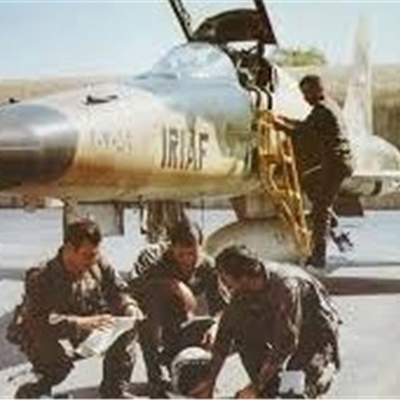Sites
Mehrabad 1st Tactical Air Base
Mohsen Shir-Muhammad
240 Views
The Mehrabad 1st Tactical Air Base, located in western Tehran as the primary air base, played a significant role in the air battles during the Iran-Iraq War.
Mehrabad Airport has two civilian and military sections. Located in the northern part of the airport, the civilian section handles passenger operations, while the military one, known as the 1st Tactical Air Base, is situated in the southern part.
The history of Mehrabad base dates back to the period before World War II. Following the occupation of Iran by the Allies in September 1941, the British Air Force seized Mehrabad Airport and stationed its aircraft there.[1] After the war ended and the Allies withdrew, the development of Mehrabad Airport began in both its military and civilian sections. In 1951, the first international aviation competition in Iran was held at Mehrabad Airport. With the arrival of the first T-33 aircraft in 1956, Mehrabad became the first tactical air base equipped with fighter jets. Later, F-84, F-86, F-5, and F-4 were added to Mehrabad’s aircraft inventory.[2]
In the 1970s, with the expansion of the Iranian Army Air Force, the Mehrabad 1st Tactical Air Base was equipped with various fighter jets, transport aircraft, and helicopters. In 1980, the base had 63 F-4s, 19 F-5s, 27 C-130 transport aircraft, 15 Boeing 707s, 11 Boeing 747s, 18 Fokker F-27s, and 3 Falcon jets.[3]
On September 22, 1980, Mehrabad was one of the first airports targeted by an Iraqi air attack. In this attack, three Boeing 707s and one Boeing 747 sustained minor damage, one C-130 and one Boeing 747 were destroyed, and one person was martyred. Subsequently, to prevent further losses, the authorities decided to transfer aircraft to other airports.[4]
On September 23, 1980, the Iranian Air Force carried out a major operation called Kaman-99 against Iraq’s key military bases and centers, during which 12 cross-border sorties were launched from Mehrabad.[5]
Also, as the enemy advanced in northern Khuzestan and the Vahdati Air Base in Dezful required air reinforcement to counter Iraqi ground forces, several F-5 and F-4 fighter jets took off from Mehrabad Airport to help defend the area.[6]
One of the units at Mehrabad base during the Iran-Iraq War was the 11th Reconnaissance Squadron, equipped with RF-4 aircraft capable of doing aerial photography. This unit’s activities included capturing aerial photographs deep inside Iraqi territory and along the frontlines, which played a crucial role in guiding armed forces commanders in planning various operations and directing friendly forces on the battlefield. For instance, in Operation Beit al-Muqaddas and the liberation of Khorramshahr, this squadron conducted 22 sorties to do aerial photography of the southern front.[7]
Another key aspect of Mehrabad’s strategic significance was the presence of Boeing 707 and 747 aircraft. They were used during the war for transporting the Iranian troops and ammunition as well as the evacuation of the wounded. Furthermore, the personnel of Mehrabad were responsible for the repair and maintenance of large and complex aircraft, ensuring they remained operational until the end of the war.[8] In addition, aerial refueling of F-4 and F-14 fighter jets in the war was one of this unit’s contributions. For example, in early 1981, as part of a strategic operation, the Air Force attacked Iraq’s H-3 air bases near the border with Jordan and destroyed the enemy facilities and several aircraft. This operation would not have been possible without the Boeing 707 and 747 tanker aircraft.[9]
The F-27s and the C-130 aircraft squadrons were other units involved in transporting military personnel and the wounded[10] during the war.[11]
One of the most tragic incidents in Mehrabad’s history happened in the C-130 unit. On September 29, 1981, after Operation Thamen al-Aemmah (as) and the breaking of the siege of Abadan, a C-130 aircraft carrying senior commanders of the Army and the Islamic Revolutionary Guard Corps (IRGC) crashed near Tehran resulting in the martyrdom of the commanders.[12]
The helicopter squadron of the Mehrabad base also carried out significant operations during the Iran-Iraq War. For example, this unit participated in Operation Kheibar (February-March 1984) which led to the capture of the Majnoon Islands.[13]
Throughout the war, specialized electronic intelligence (ELINT) aircraft were stationed at Mehrabad conducting flights along Iran’s western and southwestern borders to monitor and report enemy military and air movements.[14] After the war, changes were made to the structure of the flight units at Mehrabad. In 1988, the 11th Reconnaissance Squadron and its RF-4 aircraft were transferred to the Martyr Nojeh Air Base in Hamedan, and in 1990, new MiG-29 fighter jets were stationed at Mehrabad in their place.[15] Later, new Su-24 bomber aircraft were also deployed at the base.[16]
Following the Iran-Iraq War, Mehrabad and its transport aircraft have consistently played a role in helping people during natural disasters by delivering various forms of aid to those affected.[17]
Currently, Mehrabad serves as the primary air base, supporting other air bases across the country. Various Air Force fighter jets and transport aircraft also undergo overhaul at Mehrabad. Moreover, using its fighter aircraft, the base is responsible for ensuring the security of Tehran’s airspace.[18]
Among the prominent commanders of the Mehrabad base during the Iran-Iraq War were Colonel Pilot Javad Fakouri (martyred) and Colonel Pilot Houshang Sediq (deceased) both of whom later rose to command the Army Air Force.[19] Currently, Brigadier General Pilot Bahman Behmard commands the base.[20]
Since 2012, the Mehrabad 1st Tactical Air Base has been named the Martyr Lashkari Air Zone in honor of Major General Pilot Hussain Lashkari, who was a prisoner of war in Iraq for 18 years.[21]
[1] Tolouei, Morteza, Tarikh-e Niru-ye Havayi-ye Shahanshahi (History of the Imperial Iranian Air Force), Tehran, Entesharat-e Niru-ye Havayi, 1355, p. 117.
[2] Ibid., Pp. 195, 211, 217, 220, 271, 279.
[3] Gorouh-e Moallefin-e Tarikh-e Defa Muqaddas-e Havayi, Tarikh-e Nabardhaye Havayi – Ta Aghaz-e Tahajom-e Sarasari-ye Araq (History of Aerial Battles – Until the Start of Iraq’s Full-Scale Invasion), Vol. 1, Tehran, Markaz-e Entesharat-e Rahbordi-ye Nahaja, 1393, Pp. 389, 394.
[4] Heyat-e Tadvin-e Tarikh-e Defa Muqaddas, Taqvim-e Mostanad-e Amalkard-e Niru-ye Havayi Artesh-e Jomhouri-ye Eslami-ye Iran (Documented Calendar of Islamic Republic of Iran Army Air Force Performance), Vol. 3, Mehr 1359, Tehran, Markaz-e Entesharat-e Rahbordi-ye Nahaja, 1397, Pp. 11, 12.
[5] Ibid., p. 64.
[6] Shir-Muhammad, Mohsen, Paydari-ye Vahdati – Tarikh-e Paygah-e Chaharom-e Shekari-ye Dezful (Vahdati’s Endurance – History of Dezful’s 4th Tactical Air Base), Vol. 1, Tehran, Markaz-e Entesharat-e Rahbordi-ye Nahaja, Pp. 163, 329.
[7] Shir-Muhammad, Mohsen, Cheshman-e Oqab (Eagle Eyes), Tehran, Markaz-e Entesharat-e Rahbordi-ye Nahaja, 1396, Pp. 9, 219.
[8] Moarrefi-ye Yegan-e Tarabari-ye Niru-ye Havayi (Introducing the Air Force’s Transport Unit), Mahname-ye Saf, No. 60, Azar 1363, Pp. 10–13.
[9] Gorouh-e Asatid-e Maaref-e Jang, Maaref-e Jang (War Studies), Tehran, Entesharat-e Iran Sabz, 1393, p. 302.
[10] Gordan-e Hamlo Naql-e F-27 (F-27 Transport Squadron), Mahname-ye Saf, No. 59, Aban 1363, Pp. 41, 45.
[11] Barfaraz-e Eqtedar – Goftogu ba Farmandeh-ye Paygah-e Havayi-ye Shahid Lashkari (Soaring with Power – Interview with the Commander of Shahid Lashkari Air Base), Mahname-ye Saf, No. 384, Bahman 1391, p. 27.
[12] Orooj az Khak be Aflak (Ascension from Earth to the Heavens), Mahname-ye Shahed Yaran, Nos. 107–108, Shahrivar–Mehr 1393, p. 76.
[13] Parvaz dar Shab – Goftogu ba Sardar Jalali Farmandeh-ye Havanirooz dar Zaman-e Amaliyat-e Kheibar (Night Flight – Interview with General Jalali, Commander of the Army Aviation during Operation Kheibar), Kheibar Shekanan, Vijeh-Nameh, No. 2, Esfand 1386, p. 45.
[14] Khalili, Hussain, Nabardhaye Havayi-ye Iran (Iran’s Aerial Battles), Tehran, Iran Sabz, 1398, p. 339.
[15] Pardis, Reza, Dar Ghorbat Jangidim (We Fought in Exile), Tehran, Iran Sabz, 1388, p. 149.
[16] Lahouti, Hassan, Karanameh va Khatere-ye Hashemi Rafsanjani dar Sal-e 1371 (Record and Memoirs of Hashemi Rafsanjani in 1992), Tehran, Nashr-e Maaref-e Enqelab, 1394, p. 570.
[17] Nosrati, Mehrdad, Hamaase-ye Amaliyat-e 140 Forvandi dar Goftogu ba Farmandeh-ye Paygah-e Yekom-e Shekari (The Epic of the 140-Sortie Operation – Interview with the Commander of the 1st Tactical Base), Mahname-ye Saf, No. 458, Mehr 1398, p. 37.
[18] Barfaraz-e Eqtedar – Goftogu ba Farmandeh-ye Paygah-e Havayi-ye Shahid Lashkari (Soaring with Power – Interview with the Commander of Shahid Lashkari Air Base), Ibid., Pp. 27, 28.
[19] Qazi Mirsaeed, Seyyed Hekmat, Cheshmi dar Aseman (An Eye in the Sky), Tehran, Entesharat-e Sazman-e Aqidati-Siasi-ye Artesh, p. 18; Khabar Online, 23 Tir 1399, www.khabaronline.ir/news/1409703.
[20] Khabargozari-e Tasnim (Tasnim News Agency), 11 Mordad 1400, www.tasnimnews.com/fa/news/1400/05/11/2547866.
[21] Khabargozari-e Fars (Fars News Agency), 13 Esfand 1391, www.farsnews.ir/news/13911212001049.





